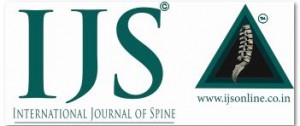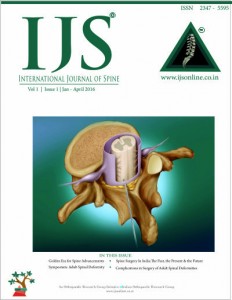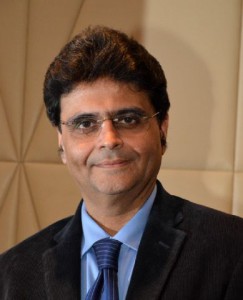Spine Surgery In India The Past, The Present & The Future
Vol 2 | Issue 1 | April – June 2016 | page:3-4 | Dr. Ram Chaddha
Author: Dr. Ram Chaddha [1]
[1] President – ‘Association Of Spine Surgeons of India – 2015-17’
President – ‘Bombay Orthopaedic Society – 2015-16’
Council Member – ‘APOA/ APSS – 2016-17’
Prof. of Orthopaedics – K.J. Somaiya Medical College, Mumbai
Consultant – Lilavati, Wockhardt, Saifee Hospitals – Mumbai
Spine Surgery In India The Past, The Present & The Future
“It is the best of times….
It is the worst of times….”
PAST: As I look back over the past three decades, I can but reminisce over how much things have changed and yet how little things have changed in “Spine Surgery” in our country. The only permanent thing in life is “change”, but has this “change” really changed anything?
As a young Orthopod in training, from 1986-88, I recollect the despair, disgust and desperation of holding a retractor, almost falling asleep and into the surgical wound, as my most respected senior surgeon spent hours battling his way through an “ Antero-lateral decompression” for a tuberculosis of the mid-thoracic spine. I recollect having sworn, that I would never do this sub-specialty in my future. Probably this was just the “caterpillar” being challenged and the transformed “butterfly” became a ‘Spine Surgeon”.
PRESENT: The long drawn procedures with low illumination, poor magnification and less optimized anesthesia, have been replaced by much better intra-operative conditions, making the “objective “ surgical environment better, but…
Have outcomes really improved? Have the fears and reservations of patients reduced? Have surgical indications become more rationalized? – The answers to the three aforementioned questions are – YES & NO. This is the paradox that the “Spine Surgeons” face today.
Have outcomes really improved?
Both Orthopaedic & Neurosurgery trained Spine Surgeons practice this unique sub-specialty, which truthfully should be a team approach, so well conceptualized and executed at very few centres in our country. Conventional long incisions have been challenged by “minimal access” approaches, supposedly reducing the morbidity. However, have we truly found a solution that optimally and adequately does the basics of spine surgery – decompression/ stabilization/ reconstruction/correction? – YES & NO.
Have the fears and reservations of patients reduced?
Much as it may appear that patients are consenting easily to “spine surgery”, the fears and reservations still remain. The image of the anecdotal and at times factual post-operative paraplegic with incontinent sphincters, looms large on the mind of the lesser informed. The Internet savvy, better informed yet lesser learned, challenge the wits of the treating surgeon putting him on the defensive making him medico-legally tentative and compromising decisions at times. This aspect of the “patient & family psyche” needs significant re-education and proper direction. Have we found an “S.O.P” (Standard Operating Procedure) for this? – YES & NO.
Have surgical indications become more rationalized?
Much as surgeons may feel convinced that all surgical indications are algorithmic and based on evidence-based decisions, there is the humongous pressure of the trade and industry which seems to be driving the evidence and channelizing or polarizing techniques, approaches and expensive consumables making “gold standard” healthcare out of the reach of the common man. The “eye does not see, what the mind does not know”. There are large caveats in our practice that remain mystical. The degenerated disc, the adjacent segment disease and of course the clinico-radiological mismatch very often hound the wits of even the most brilliant minds. Are we reaching the “correct answer” or is it still a “perception of truth”? – YES & NO.
FUTURE: I have a dream, yet unfulfilled which is futuristic.
The surgical decision should be taken only when all other measures seem inadequate. Patient evaluation, counseling, consenting with risk-benefit stratification made more elaborate, critical and standardized. A complete “SWOT – Strength-Weakness-Opportunity-Threat Analysis” of the procedure offered be available for and understood by the patient and the family. No fine print. NO E & O – Errors and Omissions – Excuse. NO* – *CONDITIONS APPLY.
The thinking process of the patient and the treating surgeon needs to change. The patient needs to respect the “intent to treat” of the surgeon and not look at him as a service provider and himself as a consumer. The “Spine Surgeon” should be more realistic in his commitment of post-operative result and be “Godly” not “God”.
The “Make In India” initiative should look at local and regional solutions to “Spine Surgeries”, both as regards decision-making and surgical options.
I strongly believe in “First, do no harm …” – commonly attributed to Hippocrates of Kos, c. 460 BC.
We all need to “pause” and “think”….
– How am I doing?
– What am I doing?
– Where am I going?
It is far less frustrating to have a non-surgical unhappy patient rather than a post-operative unhappy patient….
The author is
Ram Chaddha, M.S. (Orth.)
| How to Cite this Article: Ram C. Spine Surgery In India: The Past, the Present & the Future…. International Journal of Spine Apr – June 2016;1(1):3-4. |





